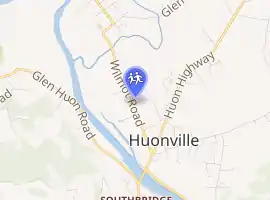Huonville High School
Huonville High School is a government co-educational comprehensive secondary school located in Huonville, a town to the south of Hobart, Tasmania, Australia. Established in 1940, the school caters for approximately 400 students from Years 7 to 12. The school is administered by the Tasmanian Department of Education.
| Huonville High School | |
|---|---|
| Location | |

| |
Australia | |
| Coordinates | 43°01′27″S 147°02′43″E |
| Information | |
| Type | Government comprehensive secondary school |
| Motto | Forward honourably |
| Established | 1940 as Huonville Area School |
| Status | Open |
| School district | Southern |
| Educational authority | Tasmanian Department of Education |
| Oversight | Office of Tasmanian Assessment, Standards & Certification |
| Principal | Geoff Williamson |
| Teaching staff | 33.3 FTE (2019)[1] |
| Years | 7-12 |
| Gender | Co-educational |
| Enrolment | 408[1] (2019) |
| Campus type | Regional |
| Houses |
|
| Colour(s) | Red, white, yellow and blue |
| Website | huonvillehigh |
In 2019 student enrolments were 408.[1] The school principal is Geoff Williamson.
Description
The school was founded in 1940 as the Huonville Area School, and was the only secondary school south of Hobart (the state capital, approximately 42 kilometres (26 mi) north). In 1957, the school was re-branded as a 'Comprehensive Area School', and during this time over 90% of students reached the school via bus, which portrays the importance the school played in the Huon Valley's education system.
Being part of the State Government's Department of Education, the school has often experienced tight budgets. This has resulted in a certain degree of dilapidation in parts of the school. The Science and Technology block in particular is in a state of mild disrepair. The food sciences and drama sectors have recently received impressive renovations from funds by the Performing Arts Department.
The school enrolled approximate 450 students in 2004, with around 100 students in each grade. Gender ratios are surprisingly equal, with almost 50/50 spreads across all grades. Approximately 15% of students identify as Aboriginal or Torres Strait Islander.
The school boasts increasingly higher rates of college level education continuation, with almost 80% of graduating students continuing to Grades 11 and 12 over the past two years. The school also hosts a 'No Dole' charter, wherein graduating students pledge to continue through to higher education or obtain full-time work, rather than seeking government welfare, thus breaking the cycle of poverty and unemployment that pervades in the Huon.
The school uniform consists mainly of a royal blue polo shirt, navy blue wind-cheater/polar fleece jacket or a blue rugby jumper, with the choice of shoes, pants, etc. left to students. However grade 10 students in the SRC wear red polo shirts. This policy results in a higher willingness to wear the uniform, and has seen marked increase in uniform compliance over the past 5 years.
The school won the Zayed Future Energy Prize in January 2017. The student team with leadership of Tobi Thorp won a staggering $US100,000 to implement a renewable energy strategy at the school.
On 9 August 2011 Huonville High took a group of grade 9 and 10 students to Devonport to participate in the 2011 Tasmanian Science and Engineering (Super) Challenge, the challenge was the state final with 2nd and 1st place being invited to attend the National Challenge in Victoria. Unfortunately Huonville came 3rd place losing out to Launceston Christian School (1st) and Calvin. On the bright side Huonville was the best performing school in Southern Tasmania and was the best performing public (non private school,) additionally this was the first time that Huonville High had made a state final with organizers commenting on how well behaved the students were when compared to other schools at the challenge.
The School offers many vocational certificates and TQA accredited courses, including Maths Methods 2. A new state funded Trade Training Centre located opposite the school offers further vocational study areas throughout the duration of High School and after.
References
- "Huonville High School, Huonville, TAS: School profile". My School. Australian Curriculum, Assessment and Reporting Authority. 2019. Retrieved 22 October 2020.